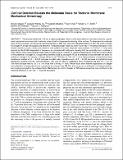Col11a2 Deletion Reveals the Molecular Basis for Tectorial Membrane Mechanical Anisotropy
Author(s)
Masaki, Kinuko; Gu, Jianwen Wendy; Ghaffari, Roozbeh; Chan, Gary; Smith, Richard J.H.; Freeman, Dennis M.; Aranyosi, Alexander J.; ... Show more Show less
DownloadMasaki-2009-Col11a2 Deletion Rev.pdf (443.6Kb)
PUBLISHER_POLICY
Publisher Policy
Article is made available in accordance with the publisher's policy and may be subject to US copyright law. Please refer to the publisher's site for terms of use.
Terms of use
Metadata
Show full item recordAbstract
The tectorial membrane (TM) has a significantly larger stiffness in the radial direction than other directions, a prominent mechanical anisotropy that is believed to be critical for the proper functioning of the cochlea. To determine the molecular basis of this anisotropy, we measured material properties of TMs from mice with a targeted deletion of Col11a2, which encodes for collagen XI. In light micrographs, the density of TM radial collagen fibers was lower in Col11a2 –/– mice than wild-types. Tone-evoked distortion product otoacoustic emission and auditory brainstem response measurements in Col11a2 –/– mice were reduced by 30–50 dB independent of frequency as compared with wild-types, showing that the sensitivity loss is cochlear in origin. Stress-strain measurements made using osmotic pressure revealed no significant dependence of TM bulk compressibility on the presence of collagen XI. Charge measurements made by placing the TM as an electrical conduit between two baths revealed no change in the density of charge affixed to the TM matrix in Col11a2 –/– mice. Measurements of mechanical shear impedance revealed a 5.5 ± 0.8 dB decrease in radial shear impedance and a 3.3 ± 0.3 dB decrease in longitudinal shear impedance resulting from the Col11a2 deletion. The ratio of radial to longitudinal shear impedance fell from 1.8 ± 0.7 for TMs from wild-type mice to 1.0 ± 0.1 for those from Col11a2 –/– mice. These results show that the organization of collagen into radial fibrils is responsible for the mechanical anisotropy of the TM. This anisotropy can be attributed to increased mechanical coupling provided by the collagen fibrils. Mechanisms by which changes in TM material properties may contribute to the threshold elevation in Col11a2 –/– mice are discussed.
Date issued
2009-05Department
Harvard University--MIT Division of Health Sciences and Technology; Massachusetts Institute of Technology. Department of Electrical Engineering and Computer Science; Massachusetts Institute of Technology. Research Laboratory of ElectronicsJournal
Biophysical Journal
Publisher
Elsevier
Citation
Masaki, Kinuko, Jianwen Wendy Gu, Roozbeh Ghaffari, Gary Chan, Richard J.H. Smith, Dennis M. Freeman, and A.J. Aranyosi. “Col11a2 Deletion Reveals the Molecular Basis for Tectorial Membrane Mechanical Anisotropy.” Biophysical Journal 96, no. 11 (June 2009): 4717–4724. © 2009 Biophysical Society
Version: Final published version
ISSN
00063495
1542-0086